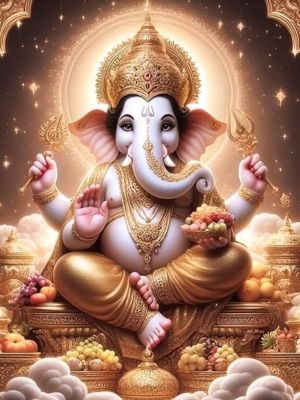Lord Ganesha

Remover of Obstacles
The universe is a cosmic machine, according to Hindu texts, and the various Gods described in the Vedas are likened to administrators of said machine. Each deity either represents or is in charge of some aspect of life.
Ganesha is prominently known as the remover of obstacles. Because of this, many Hindus worship him before any major endeavor they undertake – be it business, marriage, childbirth, etc. More importantly, however, he also removes obstacles on the soul’s spiritual journey and, is therefore, prayed to by aspiring transcendentalists all over the world.
In addition, Ganesha is also known as the guardian of esoteric knowledge. It is no surprise, therefore, that he is considered the presiding deity of astrology. Practitioners of the Vedic science pray to him, believing he has an intimate understanding of how the planets affect the karma and destiny of each soul.
Ganesha’s mercy is regularly invoked by those who chant the mantra, om gam ganapataye namaha, which means: “I offer my obeisances to Ganesha, the remover of obstacles.” Furthermore he is celebrated every year with a 10-day festival called Ganesha Chaturthi, in honor of his birthday.
Son of Shiva and Parvathy
One of the most broadly worshipped and endearing figures in Vedic culture, Ganesha is most widely recognized, perhaps, for having the head of an elephant.
In the book “Ganesha: The Auspicious…The Beginning,” Shakunthala Jagannathan and Nanditha Krishna explain there are different stories in Hindu texts regarding the origin of Ganesha that appear to be contradictory.
In one story, the devas (gods) approached Shiva for help because they were being harassed by the demons. Shiva consented by producing from his mind a glowing child with the head of an elephant and a trident in one hand. From that point forward, Ganesha became known as the mind-born son of Shiva who would protect the devas. Shiva’s wife Parvati then placed him on her lap and said that any endeavor, whether human or divine, could only be successful after praying to Ganesha. Shiva then appointed Ganesha as leader of the ganas (celestial hordes).
In an altered version of this story, when Shiva created Ganesha, Parvati, who was bothered to have had no contribution to his creation, willed Ganesha’s head to be turned into that of an elephant’s. After seeing the elephant-headed child, Parvati felt great love for him, and then said no endeavor would succeed without a prayer to the boy.
The most widely known account of Ganesha’s birth centers around a particular time Parvati decided to take a bath. While Shiva was away meditating, Parvati removed a layer of oil and dust from her body, which she shaped into the figure of a young boy. She brought the boy to life and, after telling him he was her son, instructed him to stand guard while she went in to take a bath. When Shiva returned, Ganesha blocked his path, not allowing him to see Parvati. Unaware Ganesh was his son, Shiva became furious and fought the boy before eventually cutting off his head. After discovering what had transpired, Parvati became so sad, she threatened to destroy the heavens and earth. Shiva then pacified Parvati by instructing the ganas to go out and bring the head of the first living being they could find with it’s head pointed towards the north, known as the auspicious direction associated with wisdom. The ganas returned with the head of an elephant, which Shiva placed on the trunk of Ganesha, bringing him back to life. Many view Ganesha’s decapitation as a symbol of transformation one must undergo to progress on the path of spirituality.
Though seemingly contradictory, the multiple origin stories sometimes attached to various figures in Hinduism often act as a way to highlight particular moral lessons. Numerous depictions also help in conveying Hinduism’s diversity, openness and pluralistic nature.